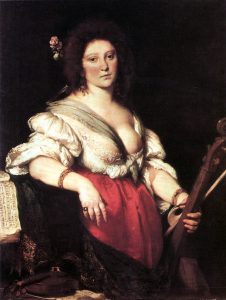
“The Viola da Gamba Player”, portrait of Barbara Strozzi, by Bernardo Strozzi, c. 1630s.
Music Period: Baroque era (1600 – 1750)
Location: Venice, Italy
Claim to Fame: Barbara published eight collections of her works and her music used the words with the music to portray meaning.
There lies an air of mystery when looking at Barbara Strozzi (1619 – 1677). What we do know, however, brings to light an intriguing musical figure who is one of the most outstanding female composers in history. From a young age, she studied under respected musicians, and went on to publish eight collections of her music within her lifetime. This was an incredible achievement in the male-dominated world of the seventeenth century.
Barbara Strozzi was born in 1619 to Isabella Garzoni. The identity of this woman is largely uncertain. We know Isabella lived in the in the household of the great Venetian intellectual, Giulio Strozzi. In 1628 he mentions Isabella in his will as his long-time servant. Giulio adopted Barbara soon after she was born and may or may not have been her father. The little girl would live with her mother in the households of women and would be trained as a musician whilst their protector travelled. Barbara studied with the singer and leading composer of the time, Francesco Cavalli, before attending the Accademia degli Unisoni (set up by her adoptive father in 1637). The academy was devoted largely to music, and academy meetings focused on a different topic of discussion each week. These debates were broken up with musical interludes that heavily featured Barbara Strozzi. It was important for Giulio to display his daughter’s talents as a musician and, on occasion, as a composer.
Thanks to the efforts made by her father, Barbara became widely known, particularly as a singer. She developed an outstanding soprano voice and was described as “la virtuosissima cantatrice” – an extremely virtuosic singer – by composer Nicolò Fontei in 1635, after he dedicated his first published volume of Bizzarrie Poetiche to her. There does, however, seem to be more to her father’s ambition than to merely establish his daughter as a musician. Giulio wanted her to be musician, composer, and courtesan. The life a courtesan relied on music-making and sexual availability. Their most essential and marketable skills were playing music, singing, and composing poetry. It was about this time the sole surviving portrait of Barbara Strozzi appears. The painting depicts her prominently as a sexual object and musician. But life as a courtesan was entangled with social politics. In the case of Barbara Strozzi, this involved her father’s patron, and perhaps friend.
Whether intentional or not, Barbara fell pregnant with her first child in the early 1640s by Giovanni Paolo Vidman – the aforementioned patron and friend. There is evidence in a letter written after Barbara’s death that suggests she “was raped by the Count Vildman [sic], a Ventian nobleman, and had a son who bears the name Giulio Strozzi” (Sounds and Sweet Airs, 2016). It could well be this story was circulated in order to protect Barbara’s reputation within society. Whether this account is true or not, Giovanni fathered two more children – Isabella in 1642 and Laura in 1644 – as well as a possible fourth. These events saw Barbara stuck in a state somewhere between married and unmarried woman. Giovanni never moved to marry Barbara as he was already married, and he did not take on the responsibility to arrange a marriage with another. Despite this, he took his financial responsibilities as a father seriously. With the help of his family, Giovanni ensured that all the children were provided for. This included a dowry for the two daughters to enter the convent of San Sepolcro after his death in 1648. Surprisingly, it was his widow, Camilla Vidman, who paid the dowry.
The financial provisions from Giovanni, however, may not have been enough to ensure a living for the family. This is where Barbara’s education came in handy. The composition instruction she received as a young girl enabled her to compose music herself and in 1644 her First Book of Madrigals was published. They were musical pieces composed to poems written by her father and were dedicated to Vittoria della Rovere, the Grand Duchess of Tuscany. From 1651 – 1664, Barbara Strozzi would publish a further seven collections with an obvious ambition to assert herself as a composer. These compositions are complex, coherent works with strong messages. Yet despite all her efforts, she remained a composer of musical miniatures like arias and cantatas. The time, the place, and her gender simply went against her. What makes Barbara Strozzi unique, however, is that she continued publishing music in spite of this.
Come May 1677, Barbara was still living in Venice. Then, for reasons unknown, she moved to Padua, where she fell ill. Sadly, she died in November of that year. During her lifetime, Barbara Strozzi gained fame as a virtuous singer, but struggled to gain professional recognition for her work as a composer. She looked to do something quite modern, and create a following, which she did relatively successfully. Unlike her male counterparts, Barbara Strozzi published her music as single author volumes, rather than in joint collections shared with other composers. Tourists would purchase her compositions in these volumes and circulate them throughout Europe. The result was international recognition, and many came to see Barbara as the originator of the aria in Italy. It’s sad that despite this following and her achievements in the music publishing world, Barbara Strozzi is largely forgotten today.
The book Sounds and Sweet Airs: the Forgotten Women of Classical Music, by Anna Beer (2016) is a great read for those who want to discover more about Barbara Strozzi, her life, and her achievements.
-Claire Amundson
Junior Girl
Girl Museum Inc.
